Sir Isaac Newton’s Second Law Of Gravity tells us exactly how much an object will accelerate based on the given net force.
As a baseball hitter, this law is directly applicable as the goal is to hit baseballs as hard and far as possible. When it comes to generating net force against baseballs, Mike Trout is an expert. Trout has been crushing baseballs with the league’s elite since he became a full-time regular at age 20 in 2012 (you can see some of those here). Trout’s offensive production, however, has gone to another level over the course of his career. The following table breaks up Trout’s career into two different parts, where the changes are noticeable. The numbers reflect Trout’s numbers against the league average, where anything over 100 is more and anything under is less.
| Years | wRC+ | BB%+ | K%+ | Pull%+ | Center%+ | Oppo%+ | FB%+ | GB%+ |
|---|---|---|---|---|---|---|---|---|
| 2011-2015 | 170 | 159 | 115 | 93 | 100 | 112 | 110 | 89 |
| 2016-2019 | 180 | 222 | 91 | 100 | 102 | 98 | 121 | 78 |
Trout has always produced elite offensive numbers but he’s at an entirely different level now. Trout has transformed into baseball’s best hitter by walking more, striking out less and pulling more hard-hit baseballs in the air. Trout is both barreling up more baseballs and raising the launch angle of his batted balls. Unsurprisingly, Trout had baseball’s second-best sweet-spot percentage in 2019. Trout has talked about a gap-to-gap approach in the past but recent trends show him moving away from hitting balls the other way.
During this transformation, Trout’s swing has also undergone some changes. He’s always possessed uncanny traits at the plate, whether it’s his lightning-quick hands, superb balance or ability to handle multiple pitches and locations. But Trout has improved his stance to the point where there are no real flaws in his swing. To get a gauge on just how perfect Trout’s swing is, I decided to break it down in multiple parts. I looked into everything with his swing, whether it’s his stance, his stride, rotation or extension.
To follow Trout’s step-by-step navigation towards hitting a baseball, I’ll utilize this nifty graphic from Elite Baseball Performance. This will help us walk through every step by breaking it down and following this model for successful hitting.

PHASE 1: Athletic Stance
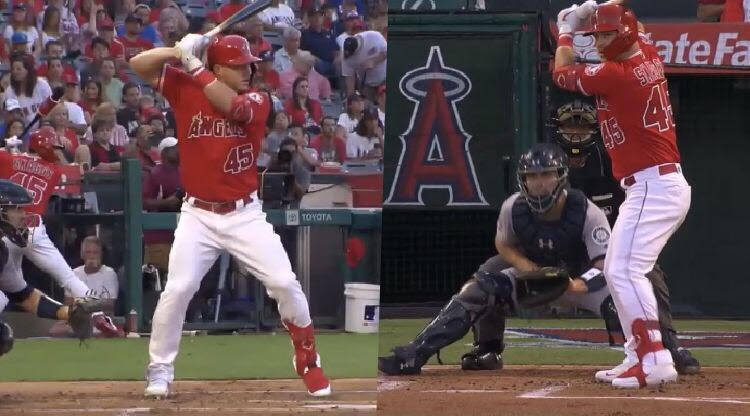
This is where everything starts. While some hitters can deviate from the norm, almost all elite hitters begin in an athletic position. Trout’s legs are balanced, with a strong back leg and a front leg that’s ready for a leg kick. His hands are positioned to cock back and begin his swing path. There is no wasted movement that may get Trout out of his rhythm. Trout’s location is also important. He’s at the very back of the box and standing right on top of home plate. He’s able to do this because of his strong mechanics which allows him to cover a ton of different pitches and locations.
PHASE 2: Load/Stride

This is possibly the most important part of the swing. Notice how balanced everything is, whether it’s his legs, hands, head or weight transfer. Trout incorporates a big leg kick without sacrificing his balance. He doesn’t fall into his back leg, which can zap the rhythm and power needed for the next phase. His hands cock back with the knob of the bat pointed towards the catcher. This is a simple move that gets his hands ready for the ideal launch into his swing path. His head doesn’t move and is center with his body throughout this whole process. As a result, Trout is not only balanced but has started generating the power necessary to launch into the next phase.
PHASE 3: Launch Position
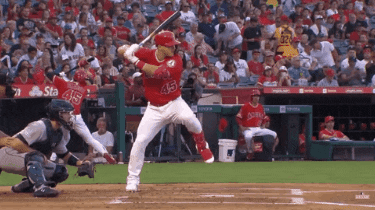
The prior balanced movements have carried over into this phase. Trout continues to show a strong balance on his back leg even when his leg comes forward. As Trout’s front leg comes forward, his hands continue to stay back. These oppositional movements create what is known as the rubber band effect, a phrase you’re probably familiar with. Trout is literally stretching his front leg and hands in different directions, creating the rubber band effect. This creates the necessary power to begin the path towards bringing the bat to the ball. Josh Donaldson explains this concept perfectly in a fascinating tutorial he did back in 2015.
PHASE 4: Rotation

The first thing to notice is his front leg. Phase 4 talks about the front foot pushing down and out, which has several benefits. It not only allows the hips to come through but it also stops the back knee, which helps generate more power. Trout is fully prepared to deliver a powerful swing on this ball.
PHASES 5-8: Connection/Swing/Extension/Follow Through

- Phase 5: Trout’s hands continue to stay back in a relaxed manner and he begins his swing. Trout doesn’t chop down on the ball (this is bad), keeps his hands in tight and lowers the barrel to match the angle of the pitch. All pitches experience the Magnus Effect, meaning gravity makes every pitch come down at a downward angle. To match the angle or get slightly under that angle, you not only have to get on the swing path early but also get on the right angle.
- Phase 6: Trout’s hands continue to stay tight and the swing plane perfectly matches in the incoming pitch. You’ll also notice that he doesn’t “squash the bug” (this is also bad) but instead drags the back foot forward. When you freeze the frame at the point of contact, you’ll see how Trout makes contact at the most ideal time.
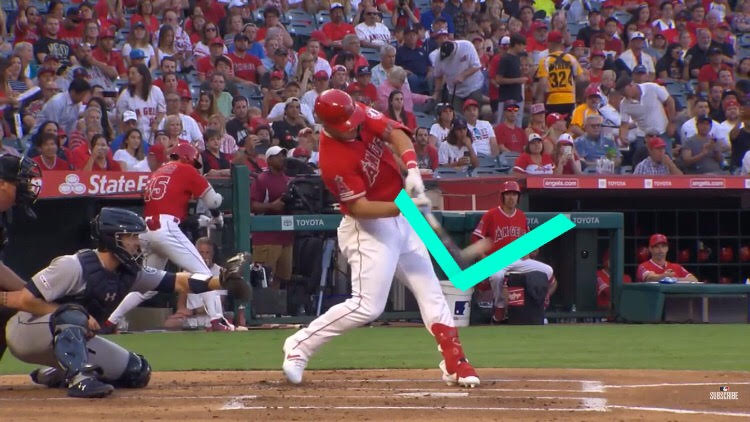
- Trout is coming out to get this pitch in front of home plate and creating the angle to crush this ball. You’ve probably heard or been on the receiving end of a coach saying to “let the ball get deep”. In reality, that idea is counterintuitive if the goal is to hit baseballs as hard as possible. If you are letting the ball get too deep, you’re losing out on potential power. This doesn’t mean you lunge forward to get baseballs but rather make contact with the ball at the most powerful point.
- Phase 7: Trout now gets into his extension, which is helped by his front leg locking and his back knee hinging down. This allows all of his power to transfer into the point of contact.
- Phase 8: Trout’s swing finishes with a strong two-handed follow-through.
The Final Product

It’s fun to watch Trout’s swing in different parts and then watch the final product. Everything about this swing just looks right. He’s in athletic positions in the entire time. His balance is nearly perfect in his legs. The hand load/leg kick creates the optimal rubber band effect. He brings his hands in tight and on the optimal angle to meet the pitch. He gets the pitch out in front of home plate with the necessary bat path to drill this baseball. Finally, he finishes the swing with strong follow-through. As a result, this baseball left the bat at 111 mph and traveled 454 feet.
Trout’s insanely consistent swing
What makes Trout so dangerous is his ability to keep his strong mechanics in place against other pitches. Trout has always mashed against pitches low in the zone but he’s now fixed his previous weakness against elevated heaters. In 2019, Trout had a .450 wOBA against fastballs, a .416 wOBA against breaking balls and a .500 wOBA against offspeed pitches. There’s also no real place to pitch to Trout anymore, as evidenced by this 2019 zone chart.

A big reason for this success is Trout’s ability to keep his mechanics in check, regardless of the pitch type and location.
High heat
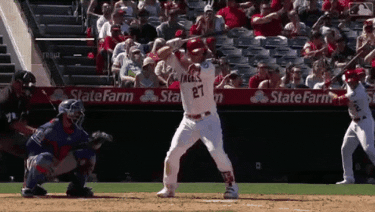
Inside fastball
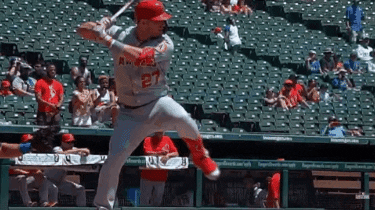
Low offspeed pitches
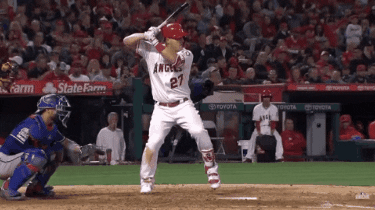
Breaking ball away
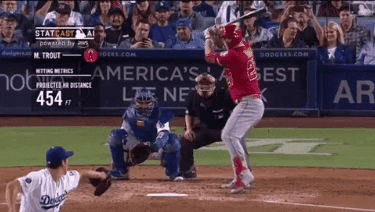
Breaking ball up

Trout is baseball’s best hitter in no small part to his flawless swing. This swing has continuously improved and made him a near-perfect hitter. Hopefully, we get to see this swing back in action sooner rather than later.
*All GIFS courtesy of MLB. Special thanks to Baseball Savant and Fangraphs for the information and Elite Baseball Performance for the graphic.
looks like Goodwin misses that pitch. I guess this is the no-hitter game where they all put the jerseys on the mound.
3 very impressive parts of his swing, his hands, hips, follow through. Generational Player, they are rare for sure. I love this kid as he is a great student to teach hitting to. I was lucky through the years and l to had a lot of good students at hitting but was never lucky enough to have a Trouty.
The hands are just so quick. It’s insane.
When Trout hit a grand slam off Chris Sale, he went waaaaay down to get that pitch. He still puts that awesome swing on it. There’s only a handful of hitters in MLB who might hit a home run off that pitch. Those that can hit it probably loop it into right field.
https://www.youtube.com/watch?v=vH7-KBqgTpg
One of my favorite home runs in franchise history. Everything about that swing and result was amazing.
It is beautiful.
Thanks for this. I’m going to have my son read this and watch the videos tonight when I get home.
Awesome!